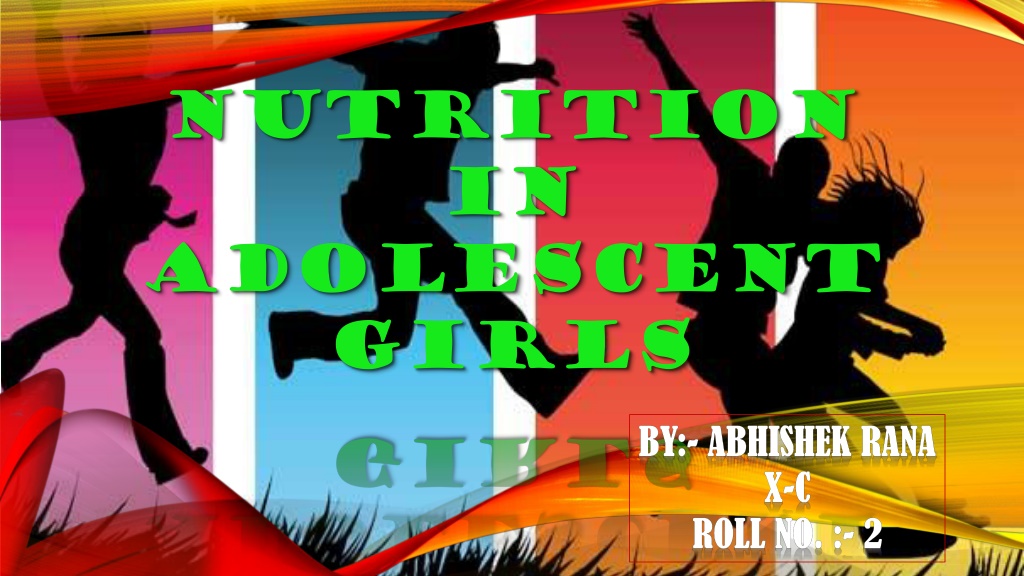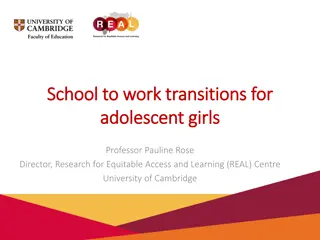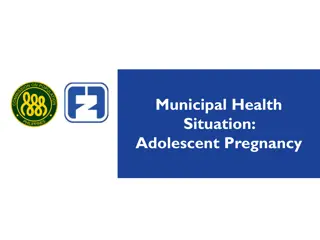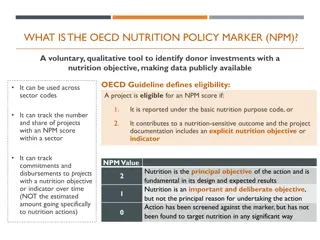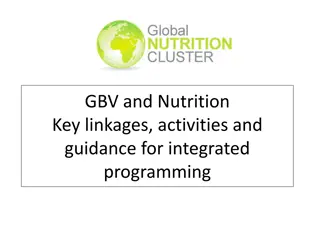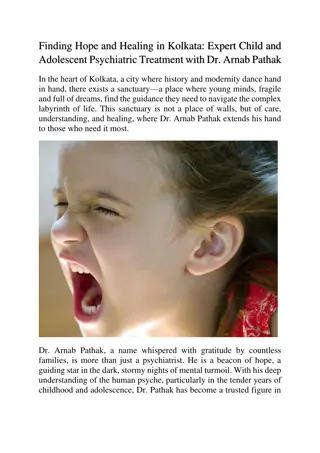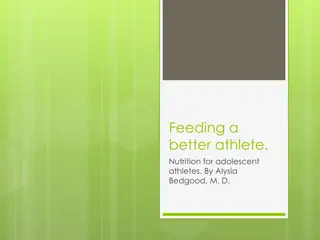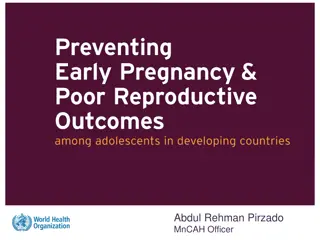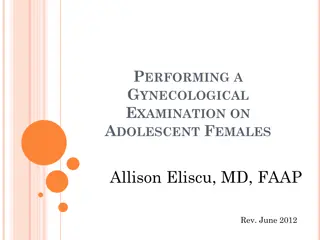Importance of Nutrition in Adolescent Girls
Adolescence is a crucial period where proper nutrition plays a vital role in supporting physical growth and preventing future health issues. Nutritional deficiencies during this time can impact a girl's development and may have repercussions on her future health and that of her offspring. Understanding the essential nutrients required during adolescence, such as energy, protein, calcium, and iron, is crucial for promoting optimal growth and development in adolescent girls.
Download Presentation

Please find below an Image/Link to download the presentation.
The content on the website is provided AS IS for your information and personal use only. It may not be sold, licensed, or shared on other websites without obtaining consent from the author.If you encounter any issues during the download, it is possible that the publisher has removed the file from their server.
You are allowed to download the files provided on this website for personal or commercial use, subject to the condition that they are used lawfully. All files are the property of their respective owners.
The content on the website is provided AS IS for your information and personal use only. It may not be sold, licensed, or shared on other websites without obtaining consent from the author.
E N D
Presentation Transcript
NUTRITION IN ADOLESCENT GIRLS BY: BY:- - ABHISHEK RANA ABHISHEK RANA X X- -C C ROLL NO. : ROLL NO. :- - 2 2
WHAT IS ADOLESCENCE ? Adolescence is the transition period between childhood and adulthood, a window of opportunity for the Adolescence is the transition period between childhood and adulthood, a window of opportunity for the improvement of nutritional status and correcting poor nutritional practices. This is about the same improvement of nutritional status and correcting poor nutritional practices. This is about the same period puberty sets in, typically between the ages of 10 and 13 years in girls. Adolescence is period puberty sets in, typically between the ages of 10 and 13 years in girls. Adolescence is characterized characterized by the growth spurt, a period in which growth is very fast. During this time, physical by the growth spurt, a period in which growth is very fast. During this time, physical changes affect the body's nutritional needs, while changes in one's lifestyle may affect eating habits changes affect the body's nutritional needs, while changes in one's lifestyle may affect eating habits and food choices. Adolescent nutrition is therefore important for supporting the physical growth of and food choices. Adolescent nutrition is therefore important for supporting the physical growth of the body and for preventing future health problems. All parents should therefore pay particular the body and for preventing future health problems. All parents should therefore pay particular attention to the nutritional needs of their attention to the nutritional needs of their teenagers teenagers
Why nutrition is essential for adolescent girls ? Any nutritional deficiency experienced during this critical period of life can have an effect on the future health of the individual and their offspring. For example, failure to consume an adequate diet at this time can result in delayed sexual maturation and delayed or retarded physical growth. The rapid physical changes of adolescence have a direct influence on a person's nutritional needs. The growth spurt that occurs in adolescence, second only to that in the first year of life, creates increased demands for energy and nutrients. Nutritional status and physical growth are dependent on one another such that optimal nutrition is a requisite for achieving full growth potential. Nutrition of the adolescent girl is particularly important but under-nutrition (too little food or food lacking required nutrients) in adolescents frequently goes unnoticed by their families or the young people themselves. Adolescence is a time to prepare for the nutritional demands of pregnancy and lactation that girls may experience in later life. Under-nutrition negatively affects adolescent girls by: Affecting their ability to learn and work at maximum productivity; Increasing the risk of poor obstetric outcomes for teen mothers; Arresting the healthy development of future children; Affecting sexual maturation and growth: and Preventing the attainment of normal bone strength and the development of healthy teeth if a youth doesn't get enough calcium.
The important nutrients that need to increase during adolescence include energy, protein, calcium, and iron. Energy Energy Energy needs of adolescents are influenced by activity level, basal metabolic rate, and increased requirements to support pub Energy needs of adolescents are influenced by activity level, basal metabolic rate, and increased requirements to support pubert ertal growth and development. Adolescents need additional energy for growth and activity. Adolescent girls need approximately 2,200 calories each day. This is a significant additional energy for growth and activity. Adolescent girls need approximately 2,200 calories each day. This is a significant in increase from childhood requirements. To meet these calorie needs, adolescents should choose a variety of healthful foods, such as lean protein sources, low calorie needs, adolescents should choose a variety of healthful foods, such as lean protein sources, low- -fat dairy products, who their energy needs, adolescents can fall prey to unhealthy, coercive and aggressive advertisement. They must therefore be wel their energy needs, adolescents can fall prey to unhealthy, coercive and aggressive advertisement. They must therefore be well i l informed in the choice of healthy foods both at home and in school. and in school. al growth and development. Adolescents need crease from childhood requirements. To meet these fat dairy products, whole grains, fruits, and vegetables. In an attempt to meet le grains, fruits, and vegetables. In an attempt to meet nformed in the choice of healthy foods both at home Fats and oils Fats and oils During adolescence, dietary fat continues to play important roles as an energy source, a significant cell structural componen During adolescence, dietary fat continues to play important roles as an energy source, a significant cell structural component, t, a precursor to agents of metabolic function and a potent gene regulator. The Australian dietary guidelines for children and adolescents recommend 25% of total energy as fat, w potent gene regulator. The Australian dietary guidelines for children and adolescents recommend 25% of total energy as fat, with ith less than 10% of energy from saturated fat for children aged over 15 years. The type of fat rather than its quantity is more important in determining the health consequence children aged over 15 years. The type of fat rather than its quantity is more important in determining the health consequences o s of dietary fat. This is because studies have shown that eating a low that eating a low- -fat diet for 8 years did not prevent heart disease, breast cancer, or colon cancer, and didn't do much for wei fat diet for 8 years did not prevent heart disease, breast cancer, or colon cancer, and didn't do much for weight loss, either. Effective strategies for reducing fat intake in children include the use of skim milk and choosing only lean meat. A positive association between dietary saturated intake in children include the use of skim milk and choosing only lean meat. A positive association between dietary saturated fa fats and total cholesterol level has demonstrated in an Australian adolescent population, although dietary factors may be more important in girls. Australian adolescent population, although dietary factors may be more important in girls. a precursor to agents of metabolic function and a less than 10% of energy from saturated fat for f dietary fat. This is because studies have shown ght loss, either. Effective strategies for reducing fat ts and total cholesterol level has demonstrated in an
Protein Protein Protein needs of adolescents are determined by the amount of protein required for maintenance of existing lean body mass and Protein needs of adolescents are determined by the amount of protein required for maintenance of existing lean body mass and the lean body mass during the adolescent growth spurt. In effect, protein is important for growth and maintenance of muscle. Adol lean body mass during the adolescent growth spurt. In effect, protein is important for growth and maintenance of muscle. Adolesc grams of protein each day. Most teens easily meet this requirement with their intake of beef, pork, chicken, eggs, and dairy grams of protein each day. Most teens easily meet this requirement with their intake of beef, pork, chicken, eggs, and dairy pro from certain vegetable sources, including tofu and other soy foods, beans, and nuts. These foods should be included in the di from certain vegetable sources, including tofu and other soy foods, beans, and nuts. These foods should be included in the diets protein intakes are consistently inadequate, reductions in linear growth, delays in sexual maturation and reduced accumulatio protein intakes are consistently inadequate, reductions in linear growth, delays in sexual maturation and reduced accumulation o the development of additional development of additional escents need between 45 and 60 ents need between 45 and 60 products. Protein is also available ducts. Protein is also available ets of vegetarians especially. When of vegetarians especially. When n of lean body mass may occur f lean body mass may occur. Calcium Calcium It is estimated 45% of peak bone mass is attained during adolescence and so adequate calcium intake is important for the deve It is estimated 45% of peak bone mass is attained during adolescence and so adequate calcium intake is important for the develop the reduction of the lifetime risk of fractures and osteoporosis. Additionally, calcium needs during adolescence are greater the reduction of the lifetime risk of fractures and osteoporosis. Additionally, calcium needs during adolescence are greater tha adulthood because of the increased demand for skeletal growth. Adequate calcium intake is essential also for development of s adulthood because of the increased demand for skeletal growth. Adequate calcium intake is essential also for development of stro adolescent growth spurt. Inadequate calcium intake during adolescence and young adulthood puts individuals at risk for develo adolescent growth spurt. Inadequate calcium intake during adolescence and young adulthood puts individuals at risk for developin order to get the required 1,200 milligrams of calcium, teens are encouraged to consume three to four servings of calcium order to get the required 1,200 milligrams of calcium, teens are encouraged to consume three to four servings of calcium- -rich fo greatest amount of calcium in the diets of adolescents, followed by cheese, ice cream and frozen yogurt. greatest amount of calcium in the diets of adolescents, followed by cheese, ice cream and frozen yogurt. Girls preoccupied with body shape might have a dilemma of including calcium Girls preoccupied with body shape might have a dilemma of including calcium- -rich dairy foods, which they perceive as fattening. carried out in 1995 found 56 per cent of Australian girls aged 9 to 13 years did not meet the recommended dietary intake for carried out in 1995 found 56 per cent of Australian girls aged 9 to 13 years did not meet the recommended dietary intake for cal The fear of getting fat through the consumption of dairy foods appears to be premature and may therefore not be a critical de The fear of getting fat through the consumption of dairy foods appears to be premature and may therefore not be a critical deter study conducted in Canada found no difference in changes in per cent body fat over two years between girls eating varying amo study conducted in Canada found no difference in changes in per cent body fat over two years between girls eating varying amount Indeed, the type of fat consumed and not the quantity of fat per se must be watched. Indeed, the type of fat consumed and not the quantity of fat per se must be watched. Empirical evidence indicates that bad fats, meaning saturated and trans fats, increase the risk for certain diseases while go Empirical evidence indicates that bad fats, meaning saturated and trans fats, increase the risk for certain diseases while good polyunsaturated fats), lower the risk. The basic idea regarding the prevention of diseases associated with fat consumption is polyunsaturated fats), lower the risk. The basic idea regarding the prevention of diseases associated with fat consumption is to to substitute good fats for bad fats. (Read more on how to reduce cholesterol in Nutrition for Lowering Cholesterol Levels) (Read more on how to reduce cholesterol in Nutrition for Lowering Cholesterol Levels) There also appears to be varying degrees to which individuals respond to dietary fat intake. Calcium There also appears to be varying degrees to which individuals respond to dietary fat intake. Calcium- -fortified foods including o and cereals are excellent sources of calcium. A study in the US showed that adolescents in the highest soft drink consumption and cereals are excellent sources of calcium. A study in the US showed that adolescents in the highest soft drink consumption ca category were found to consume less calcium and vitamin C than non less calcium and vitamin C than non- -soft drink consumers. Therefore, excessive soft drink consumption by adolescents may displac soft drink consumers. Therefore, excessive soft drink consumption by adolescents may displace the consumption of more nutrient nutrient- -dense beverages, such as milk and juices. Good sources of calcium include milk, yogurt, cheese, calcium dense beverages, such as milk and juices. Good sources of calcium include milk, yogurt, cheese, calcium- -fortified juice lopment of dense bone mass and ment of dense bone mass and than they are in either childhood or n they are in either childhood or trong and dense bones during the ng and dense bones during the ping osteoporosis later in life. In g osteoporosis later in life. In rich foods each day. Milk provides the ods each day. Milk provides the rich dairy foods, which they perceive as fattening. The National Nutrition Survey The National Nutrition Survey calcium. cium. terminant of obesity since a recent minant of obesity since a recent unts of calcium from food. s of calcium from food. od fats (that is, monounsaturated and fats (that is, monounsaturated and substitute good fats for bad fats. fortified foods including orange juice, breakfast bars, bread range juice, breakfast bars, bread tegory were found to consume e the consumption of more s, and calcium- -fortified cereals. fortified cereals. fortified juices, and calcium
Iron Iron is vital for transporting oxygen in the bloodstream. A deficiency of iron causes anaemia, which leads to fatigue, confusion, and weakness. With the onset of adolescence, the need for iron increases as direct consequence of rapid growth and the expansion of blood volume and muscle mass. As adolescents gain muscle mass, more iron is needed to help their new muscle cells obtain oxygen for energy. The onset of menstruation imposes additional iron needs for girls. The Recommended Dietary Allowance (RDA) for iron is 12-15 milligrams (mg) per day. Good sources of iron include beef, chicken, pork, legumes (including beans and peanuts), enriched or whole grains, and leafy green vegetables such as spinach. Zinc Zinc is important in adolescence because of its role in growth and sexual maturation. It is known that serum zinc levels decline in response to the rapid growth and hormonal changes that occur during adolescence. Serum zinc levels indicative of mild zinc deficiency (<10.71 x10-6 mol/L) have been found in 18% to 33% of female adolescents. The RDA for zinc for males and females ages 9-13 is 8 mg/day. For females ages 14-18, the RDA 9 mg/day. Zinc is naturally abundant in red meats, shellfish, and whole grains. Additionally, many breakfast cereals are fortified with zinc. Zinc and iron compete for absorption, so elevated intakes of one can reduce the absorption of the other. Adolescents who take iron supplements may be at increased risk of developing mild zinc deficiency if iron intake is over twice as high as that of zinc. Folate Folate plays an integral role in DNA, RNA and protein synthesis. Thus, adolescents have increased requirements for folate during puberty. Rich sources of dietary folate consumed by adolescents include ready-to-eat cereal, orange juice, bread, milk, and dried beans or lentils. Adolescents who have formed the habit of skipping breakfast or do not include orange juice and ready-to-eat cereals in their meals may be at an increased risk of low folate consumption.
Landesa Rural Development Institute (West Bengal, India) - Landesa has created a program that bestows small plots of land on families with only daughters and no sons, with the requirement that the daughter(s) be given ownership rights to the land. This way, adolescent girls can gain firsthand experience with farming their own land, and also enjoy greater authority and independence within their communities. PATNA: SABLA, a scheme for empowerment of adolescent girls, launched on International Women's Day this year, includes a complete nutrition programme for adolescent girls in the age group of 11 to 18 years. The scheme launched by state welfare minister Parveen Amanullah will be run using the Integrated Child Development Scheme ( ICDS) platform in 12 districts of Bihar. These districts are Patna, Buxar, Gaya, Aurangabad, Sitamarhi, West Champaran, Vaishali, Saharsa, Kishanganj, Banka, Katihar and Munger. There are two major components under the scheme: one, a nutrition component for 'out-of-school girls' in the age group of 11 to 14 years and for 'all the girls' in the age group of 14 to 18 years, and second, non-nutrition component for 'out-of-school' adolescent girls in the age group of 11 to 18 years and a vocational training under National Skill Development Programme for girls in the age group of 16 to 18 years. The basic objectives of the scheme are to enable self-development and empowerment of adolescent girls, improvement in their health and nutrition status, spread awareness about health, hygiene, nutrition, adolescent reproductive and sexual health, family and child care. The programme also aims at upgrading their home-based skills, life skills and vocational skills. The project will also include bringing back the out-of-school adolescent girls under the ambit of formal and non-formal education. The adolescent girls will also be guided about the existing public services, such as primary health centres, post offices, banks, police stations and others.
A 'Kishori card' will be given to each adolescent girl, wherein details about her weight, height, body mass index, iron and folic acid supplementation, referrals and services received under SABLA will be written. The card will also contain information about important milestones in the girl's life, like joining school, leaving school, marriage etc. 'Kishori Diwas' will also be celebrated as a special health day once in three months, where their general health check-up will be done. 'Kishori Samooh', a group of 15 to 25 girls, will be formed at the anganwadi centre level. One girl from amongst them will be selected as 'sakhi', the peer monitor, who will provide guidance and motivation to peers. A training kit will be provided to adolescent girls which will have a number of games and activities, making the learning process an interesting one. Anganwadi sevikas, who will oversee the running of the project, have already been given a preliminary training for the same. There are two major components under the scheme: one, a nutrition component for 'out-of-school girls' in the age group of 11 to 14 years and for 'all the girls' in the age group of 14 to 18 years, and second, non-nutrition component for 'out-of- school' adolescent girls in the age group of 11 to 18 years and a vocational training under National Skill Development Programme for girls in the age group of 16 to 18 years. The basic objectives of the scheme are to enable self-development and empowerment of adolescent girls, improvement in their health and nutrition status, spread awareness about health, hygiene, nutrition, adolescent reproductive and sexual health, family and child care. The programme also aims at upgrading their home-based skills, life skills and vocational skills. The project will also include bringing back the out-of-school adolescent girls under the ambit of formal and non- formal education. The adolescent girls will also be guided about the existing public services, such as primary health centres, post offices, banks, police stations and others.
THANK THANK YOU YOU
